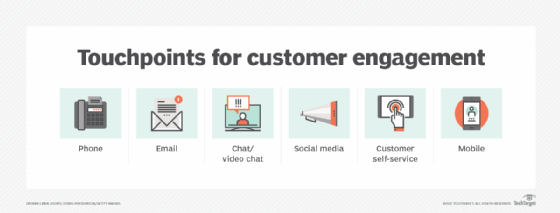Why customer journey touchpoints matter
Customer journey touchpoints allow businesses to create an excellent customer experience and drive long-lasting customer loyalty -- if understood and optimized properly.
The path to making a purchase decision is different in today's digital age than in previous decades. No longer are purchases made solely on the outreach of a sales representative to a potential buyer.
More information is available to buyers than ever before, with the internet providing an endless source of information regarding solutions to problems a buyer may be looking to solve. The initial research kicks off their buyer's journey, represented as a series of touchpoints from pre- to post-purchase
These touchpoints are crucial moments of contact between customers and brands and shape the customer experience. Understanding, optimizing and tracking these touchpoints is essential for businesses seeking to build strong relationships, boost customer satisfaction and drive growth.
What is a customer touchpoint?
A customer touchpoint is a critical point of interaction between a customer and a business throughout the customer journey. It encompasses every instance where a customer engages with a brand, product or service. These touchpoints can occur through various channels, such as the following:
- Websites.
- Phone calls.
- Email.
- Social media.
- Physical stores.
- Customer service interactions.
- Advertisements.
At each touchpoint, customers form impressions, gather information and make decisions that influence their satisfaction, loyalty and purchase intent. Successful businesses recognize the importance of delivering consistent, seamless and valuable experiences across these touchpoints, ensuring customers feel engaged, valued and supported throughout their journey.
How do customer touchpoints work?
Customer touchpoints serve as individual steps within the customer journey, creating interactions between customers and businesses. These touchpoints serve as opportunities for organizations to engage customers, influence their perception and guide them toward a desired outcome, such as a purchase or conversion. Each touchpoint acts as a stepping stone that customers encounter as they progress through their journey, which impacts their experience.

Effective customer touchpoints align with customer expectations and provide seamless transitions between stages of the journey. They should deliver relevant and valuable information, address customer pain points and offer a consistent brand experience. By carefully orchestrating touchpoints, businesses can nurture customer relationships, build trust and create positive associations with their brand. A well-executed touchpoint can generate a sense of delight, leaving a lasting impression that encourages customers to return and recommend the business to others. In contrast, poor or inconsistent touchpoints can lead to customer dissatisfaction, trust erosion and potential business loss. Therefore, businesses must carefully manage and optimize each touchpoint to ensure a cohesive and memorable customer experience.
The importance of customer touchpoints
These interactions are significant for businesses, as they play a central role in shaping that customer experience. Several reasons why these touchpoints matter include the following:
- Influence perception. Touchpoints can directly impact how a customer perceives a brand, product or service. Positive touchpoints create trust, credibility and a favorable image of the business. They can also shape customer attitudes and perceptions, influencing purchase decisions and long-term loyalty.
- Build relationships. Touchpoints are crucial for building and nurturing relationships with customers. Each interaction provides an opportunity to engage with customers, understand their needs and deliver personalized experiences. Businesses can foster trust, loyalty and advocacy by providing exceptional touchpoints, leading to repeat purchases and positive word-of-mouth.
- Foster customer satisfaction. Well-designed touchpoints address customer pain points, provide seamless experiences and offer relevant information. Businesses can enhance customer satisfaction by meeting and exceeding customer expectations at each touchpoint. Satisfied customers are more likely to remain loyal, make repeat purchases and become brand advocates.
- Drive revenue growth. Optimized touchpoints contribute to increased sales and revenue growth. By delivering exceptional experiences, businesses can differentiate themselves from competitors and attract more customers. Positive touchpoints can lead to higher conversion rates, larger average order values and increased customer lifetime value.
- Enhance customer loyalty. Consistent and positive touchpoints build customer loyalty. When customers have positive experiences throughout their journey, they are more likely to remain loyal to a brand, resist switching to competitors and become advocates. Loyal customers make repeat purchases and refer new customers, amplifying the business's growth.
- Improve customer retention. Touchpoints play a crucial role in retaining existing customers. By continually engaging and delivering value at each touchpoint, businesses can reduce customer churn and increase customer lifetime value. Keeping customers is more cost-effective than acquiring new ones, making touchpoints before, during and after a sale an essential element of customer retention strategies.
- Gather customer insight. Customer touchpoints provide valuable opportunities to gather feedback and insights from customers. By seeking feedback at different stages of their journey, businesses can understand customer preferences, pain points and expectations. These insights can inform product development, marketing strategies and business improvements.
- Customer-centric approach. Understanding touchpoints helps businesses become more customer-centric. Businesses can align their touchpoints with customer needs and preferences by analyzing customer interactions. This customer-centric approach enhances the customer experience and fosters long-term customer relationships.
How to identify and track customer touchpoints
Understanding customer touchpoints is crucial for businesses to design effective strategies that enhance customer experiences. By identifying and optimizing touchpoints, organizations can create personalized interactions, address customer needs and exceed expectations. Businesses must identify and track touchpoints across the customer journey to effectively manage them.
- Map the customer journey. Begin by mapping the customer journey, documenting each stage and touchpoint that customers encounter. This process helps visualize the entire customer experience and identify potential gaps or areas for improvement.
- Utilize analytics tools for data collection. Use analytics tools, such as web analytics platforms, marketing automation tools or a CRM database to track customer interactions on digital channels. These tools provide data on website visits, page views, click-through rates and conversion rates to help identify key touchpoints.
- Monitor social media. Monitor social media platforms to identify customer interactions, mentions and external sentiment toward a brand. Social listening tools can help track and analyze conversations related to the business, highlighting touchpoints where customers engage and express their opinions.
- Implement customer feedback vehicles. Seek customer feedback at different touchpoints through surveys, feedback forms or follow-up emails. This allows customers to express their experiences and opinions, providing valuable insights into touchpoints that need refinement or enhancement.
- Review sales and conversion funnels. Evaluate data from sales and conversion funnels to identify touchpoints where customers drop off or exhibit conversion behavior. Understanding these touchpoints helps optimize them to facilitate smooth progression through the customer journey.
- Collaborate across departments. Establish cross-functional collaboration within an organization. Engage marketing, sales, customer service and product development teams to identify and track touchpoints. Their diverse perspectives and insights can contribute to a more comprehensive understanding of customer interactions.
Customer journey touchpoint examples
Since customer touchpoints happen throughout the buyer's journey, there are endless examples of where and how these interactions occur. The following are example touchpoints that occur pre-purchase, during and post-purchase.
Pre-purchase touchpoints
- Online research. Customers may research online by visiting a company's website, reading product reviews, or exploring comparison websites to gather information and evaluate options.
- Social media engagement. Customers may interact with a brand's social media posts, ask questions or seek recommendations from their social network.
- Email marketing. Businesses can use targeted email campaigns to provide product information, offers and incentives to potential customers.
- Advertising. Customers may come across advertisements through various channels, such as search engines, social media platforms or display ads, that generate awareness and interest in a product or service.
- In-store visits. For brick-and-mortar businesses, customers may visit physical stores to browse products, ask questions and seek assistance from sales representatives.
Purchase touchpoints
- Website or app checkout. Customers go through the checkout process on a website or mobile app to complete their purchase, including adding items to the cart, entering payment information and confirming the order.
- Point of sale (POS) interaction. In a physical retail environment, customers interact with the POS system to finalize their purchase, make payment and receive their product.
- Customer service support. Customers may contact customer service representatives for help during the purchase process to clarify product details, confirm availability or resolve any issues.
Post-purchase touchpoints
- Order confirmation and delivery updates. Customers receive order confirmation emails or notifications with details about their purchase and updates on the delivery status of their product.
- Customer onboarding. For certain products or services, businesses may provide onboarding materials or tutorials to guide customers on how to best use and maximize the benefits of their purchase.
- Customer surveys. Companies may send post-purchase surveys to gather feedback on the experience, product satisfaction and any areas for improvement.








